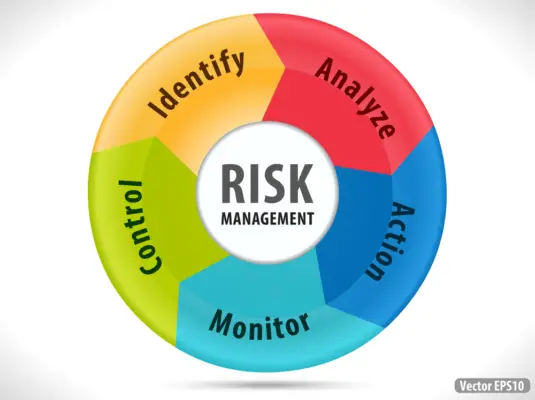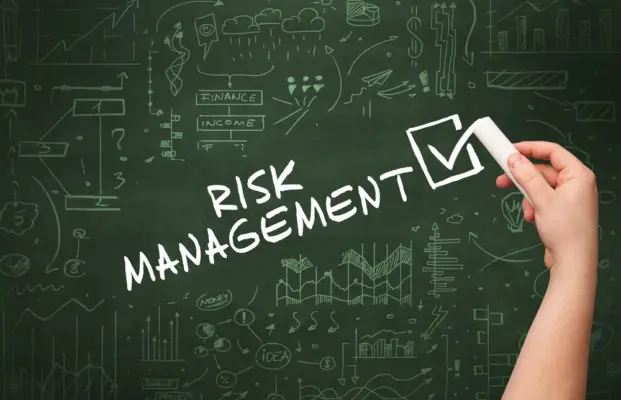Risk management is comprised of three essential components: risk identification, risk analysis, and risk prioritization. These components help businesses identify potential risks, assess the likelihood and impact of those risks, and develop strategies for mitigation. The above three components are summarized below:-
Risk Assessment: This is the initial step in the risk management process and involves identifying and analyzing potential risks. Risk assessment includes:
- Risk Identification: Identifying what types of risks could potentially impact the organization.
- Risk Analysis: Evaluating the potential consequences and likelihood of each risk.
- Risk Evaluation: Comparing risk analysis results with risk criteria to determine whether the risk and its magnitude are acceptable or tolerable.
Risk Mitigation: Once the risks have been assessed, the organization must decide how to manage them. This involves developing and implementing strategies to minimize the impact of risk. This can include:
- Risk Avoidance: Eliminating the risk by not engaging in a specific activity.
- Risk Reduction: Reducing the severity of the loss or the likelihood of the loss from occurring.
- Risk Transfer: Transferring the risk to another party, often by contract or hedging.
- Risk Acceptance: No action is taken due to a cost/benefit decision.
Risk Monitoring and Review: Risk management is an ongoing process. Once the risk mitigation strategies are in place, they should be regularly monitored and reviewed to ensure they are effective and to identify any new risks that may have arisen. This part includes:
- Monitoring: Regularly check that risk mitigation measures are working as expected.
- Reviewing: Adjusting risk management strategies as needed based on the results of the monitoring process or changes in the organization or its environment.
These components form a continuous improvement cycle that allows an organization to adapt its risk management approach over time as conditions change and as it learns more about what works and what doesn’t in managing risks. This cycle is often referred to as the Risk Management Process.
In this article, we’ll dive deeper into each component of risk management to better understand how they work together to create an effective strategy for managing risks.

Risk Identification: Identifying Potential Risks
The initial phase of the risk management process involves a systematic approach to identifying potential hazards and uncertainties that may harm an organization’s objectives, thereby enabling them to proactively mitigate or avoid such risks. Risk identification is crucial to risk management, laying the groundwork for subsequent steps.
This requires various risk assessment techniques to identify potential risks and their possible impact on an organization.
Risk identification poses several challenges that organizations must overcome to ensure effective risk management. Determining which risks are significant enough to warrant attention and resources is challenging.
Organizations must also consider both internal and external factors when identifying potential risks. Failure to consider all relevant factors could result in overlooking certain risks that could cause significant harm.
Furthermore, since not all risks can be anticipated, organizations must remain vigilant and monitor their environment for new threats.
Regular reviews of business processes should be conducted to identify any emerging risks that were previously unforeseen. By doing so, organizations can stay ahead of emerging trends and proactively manage new threats before they become unmanageable.
The first step in effective risk management is identifying potential hazards and uncertainties facing an organization through comprehensive analysis using different techniques like SWOT or PESTEL analysis while considering internal and external factors.
Despite its challenges, this phase is critical for successfully implementing risk mitigation strategies throughout an organization’s operations.
Risk Analysis: Assessing Likelihood and Impact
Assessing the likelihood and impact is crucial in effectively analyzing potential hazards, allowing for a more informed approach to managing potential issues. Risk analysis involves determining the probability of an event occurring and evaluating its consequences if it does occur.
This process helps identify vulnerabilities that may have been missed during the risk identification phase.
Organizations use various techniques, such as historical data analysis or expert judgment, to assess the likelihood. Historical data analysis involves reviewing past events to determine how often they occurred and under what conditions.
Expert judgment involves seeking opinions from individuals with relevant experience or knowledge about the assessed risks. Evaluating consequences involves identifying the potential impact of an event on an organization’s objectives, assets, reputation, and stakeholders.
After assessing likelihood and impact, organizations can prioritize risks based on severity and develop appropriate strategies to manage them.
A 4-item bullet point list that can aid in assessing vulnerabilities includes:
- Identifying critical assets that risk could impact.
- Analyzing external factors that could contribute to the occurrence of a risk
- Reviewing internal controls and procedures to identify weaknesses
- By assessing current mitigation strategies to determine their effectiveness.
Conducting a thorough risk analysis, organizations can decide which risks require attention first and allocate resources accordingly. This enables them to manage potential issues before they escalate into significant problems proactively.
Risk Prioritization: Developing Strategies for Mitigation
To effectively mitigate potential hazards, organizations must prioritize risks based on severity and develop appropriate strategies for mitigation.
Risk assessment is the process used to determine the likelihood of a specific event occurring and its potential impact. Once risks have been identified and assessed, they can be prioritized based on their severity level.
Following the risk assessment, organizations should develop mitigation plans that outline strategies for addressing each risk priority. This includes identifying specific actions that can be taken to reduce or eliminate the likelihood of the identified hazard occurring.
Mitigation planning should also include clear guidelines for implementing these measures promptly and effectively.
Effective risk prioritization and mitigation planning require a comprehensive understanding of an organization’s operations, objectives, and potential vulnerabilities.
Organizations must take proactive steps to identify potential hazards before they occur, assess their severity level, and develop customized strategies for mitigating them.
Risk Monitoring: Tracking and Reviewing Risks
As organizations continue to navigate potential hazards, it is crucial that they remain vigilant in monitoring and reviewing their risk mitigation strategies to ensure that they are effectively safeguarding against any potential threats lurking beneath the surface.
Risk monitoring involves tracking and reviewing risks continuously, which helps organizations identify new risks as they emerge. Effective risk-tracking techniques include implementing a system for recording and reporting risks, assigning responsibility for managing specific risks, and regularly updating risk assessments.
One of the main benefits of risk monitoring is that it allows organizations to quickly detect changes in their operational environment.
Additionally, regular risk monitoring provides valuable insights into how well an organization’s overall risk management strategy works and can help identify areas where improvements are needed. This information can also be used to inform future decision-making around business operations.
Effective risk management requires ongoing attention to identify and appropriately address all potential hazards. Risk monitoring is critical to this process as it enables organizations to track and review risks systematically over time.
Through effective risk-tracking techniques such as implementing a system for recording and reporting risks, assigning responsibility for managing specific risks.
Regular updating assessments, organizations can stay ahead of emerging threats while improving their overall approach to managing operational challenges.
Risk Communication: Keeping Stakeholders Informed
Effective messaging and stakeholder engagement are critical elements of risk communication, ensuring stakeholders are informed about potential risks.
Risk communication includes disseminating information to stakeholders regarding potential hazards, risk mitigation strategies, and any other relevant information needed to make informed decisions. This process is essential in preventing or minimizing losses and ensuring all stakeholders understand their role in managing risks.
Stakeholder engagement is a crucial component of risk management as it allows for open lines of communication between organizations and those affected by potential risks.
Engaging with stakeholders can help identify potential issues early on, enabling organizations to take proactive measures to mitigate or eliminate the risks. Proper stakeholder engagement fosters trust between organizations, improving stakeholder relationships.
The effectiveness of risk communication depends on how well the target audience receives the message.
It involves understanding the needs and preferences of different stakeholder groups, tailoring messages accordingly, and delivering them through various channels where they will be most impactful.
A successful risk communication strategy ensures that all relevant parties are informed throughout every stage of a project or program’s lifecycle, from planning to implementation and evaluation.
Effective messaging ensures that all parties can access timely information necessary for decision-making while minimizing confusion or misunderstandings.

Frequently Asked Questions
How does risk management differ from crisis management?
Crisis prevention and proactive planning are critical components of risk management, but how does risk management differ from crisis management?
While both concepts involve identifying potential risks and implementing measures to mitigate them, the main difference lies in their approach.
Risk management is a systematic process of assessing, analyzing, and addressing risks before they materialize into crises.
On the other hand, crisis management focuses on responding to a crisis by containing its impact and minimizing damage.
Risk management is a proactive measure, while crisis management is reactive.
Can risk management be applied to personal situations as well as business situations?
Risk management is identifying, analyzing, and assessing potential risks that may arise in a particular situation. Although it is primarily associated with business environments, risk management can also be applied in personal situations.
Personal applications of risk management include managing financial investments, health risks, and safety concerns.
The benefits of applying risk management techniques to personal situations are numerous: individuals can make informed decisions based on a thorough analysis of potential outcomes and minimize the likelihood of negative consequences.
However, there are also drawbacks to applying risk management in personal contexts. It can be time-consuming and require significant effort to gather information and analyze data thoroughly.
Additionally, some individuals may feel overwhelmed by the detail required for effective risk assessment.
How do you measure the success of a risk management plan?
Measuring the success of a risk management plan involves evaluating both quantitative and qualitative metrics.
Quantitative metrics include financial outcomes, such as the reduction of losses or insurance premiums, while qualitative metrics encompass non-financial aspects, such as stakeholder satisfaction and organizational reputation.
Best practices for risk management plan evaluation involve setting clear objectives and performance indicators at the outset, regularly monitoring progress against these measures, and incorporating feedback from stakeholders to adapt the plan over time.
Additionally, periodic reviews of the risk environment can help identify emerging threats or opportunities that may require adjustments to the existing plan.
How often should risk management plans be reviewed and updated?
An integral aspect of any risk management plan is the frequency of updates, which determines how often it should be reviewed and revised.
Organizations must adopt a proactive approach and regularly update their risk management plans rather than reactively waiting for an adverse incident.
This approach provides several benefits, including avoiding potential risks, identifying areas that require improvement or modification, and ensuring compliance with changing regulations.
Conclusion
Risk management is a crucial component of any successful business strategy. It involves identifying, analyzing, prioritizing, monitoring, and communicating potential risks to stakeholders.
The first step in this process is risk identification, where potential risks are identified and documented. This helps businesses develop a comprehensive understanding of the threats that may impact their operations.
The second step is risk analysis which involves assessing the likelihood and impact of each identified risk. This helps organizations prioritize and develop strategies for mitigation based on the level of risk involved.
Finally, effective risk communication ensures that all stakeholders are kept informed about the progress of risk management activities.
Managing risks requires a strategic approach that includes planning for contingencies before they occur. Risk management involves three key components: identification, analysis, and prioritization.

Chris Ekai is a Risk Management expert with over 10 years of experience in the field. He has a Master’s(MSc) degree in Risk Management from University of Portsmouth and is a CPA and Finance professional. He currently works as a Content Manager at Risk Publishing, writing about Enterprise Risk Management, Business Continuity Management and Project Management.


